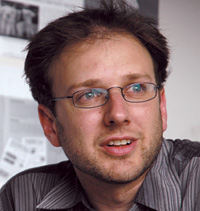From the editor: Confronting the future
 |
"Prediction is difficult, especially the future," said Niels Bohr and, apparently, many humorists since. Bohr was wont to make similar light-hearted remarks that often contained his deep insights at their core.
Now, in the midst of a particle physics revolution, labs are confronting the future head-on. But given the difficulty of prediction, sensible laboratory managers replace prediction with planning. Nothing in science is ever certain, but that doesn't mean future programs can't be designed to push frontiers while still allowing for adjustments due to unexpected discoveries. Comprehensive plans take into account a wide range of outcomes for inherently unpredictable scientific efforts and build contingencies for as many as possible.
There is no doubt that scientific opportunities at this time exceed what can be deeply investigated, due to budgetary constraints. In response, laboratories are planning research programs that maximize the quality of research that can be achieved given finite resources. Although always a desirable goal, this imperative is intensified when the difference between opportunity and funding is greatest, such as at this time, with the potential for discovery so great.
Planning under these circumstances involves making difficult decisions, but it appears that the major laboratories are well-prepared to make these decisions, in the context of a detailed plan for future research. Clear goals for both Fermilab and SLAC include the development of an International Linear Collider in concert with the rest of the global particle physics community. But wishing the ILC into existence is not enough. Initial responses from funding agencies to proposals about the ILC are tentatively being well-received because the current plans include clear decision and branch points.
The labs, however, are not investing all in a wish, and have plans to continue their successful programs. Fermilab's neutrino program continues at strength with future branch points integrated into ILC plans. For example, a proton driver experiment would exploit early work on ILC technology, whether or not the ILC proceeds. Meanwhile, SLAC has undergone a major restructuring that creates parallel Photon Science and Particle & Particle Astrophysics directorates. The creation of the Linear Collider Light Source (LCLS) arises from past plans to exploit collider technology for alternate uses, in this case to create high-intensity, short-pulse x-ray light rather than the traditional electron and positron acceleration performed in SLAC's linear accelerator.
Futures are always uncertain, but that is not necessarily problematic in a field like science, which depends on uncertainty for its vitality. Just as long as the types of uncertainties are understood, it is possible to develop plans for the future that essentially guarantee continued success, even if the nature of that success is not immediately clear. Both Fermilab and SLAC are undergoing major programmatic changes, but each appears to be coming out of the process even stronger than before, due to the heightened emphasis and understanding of what can be divined of the future.
David Harris, Editor-in-Chief
Click here to download the pdf version of this article.


